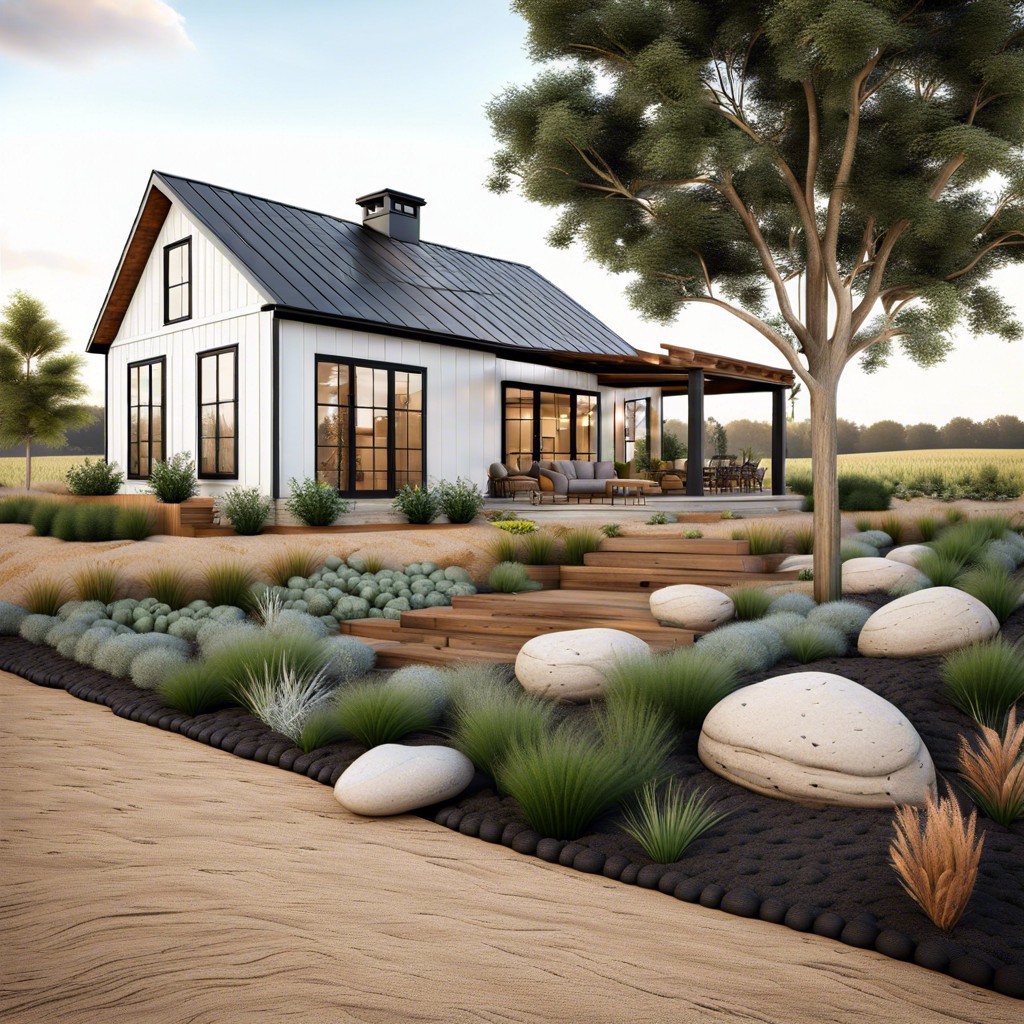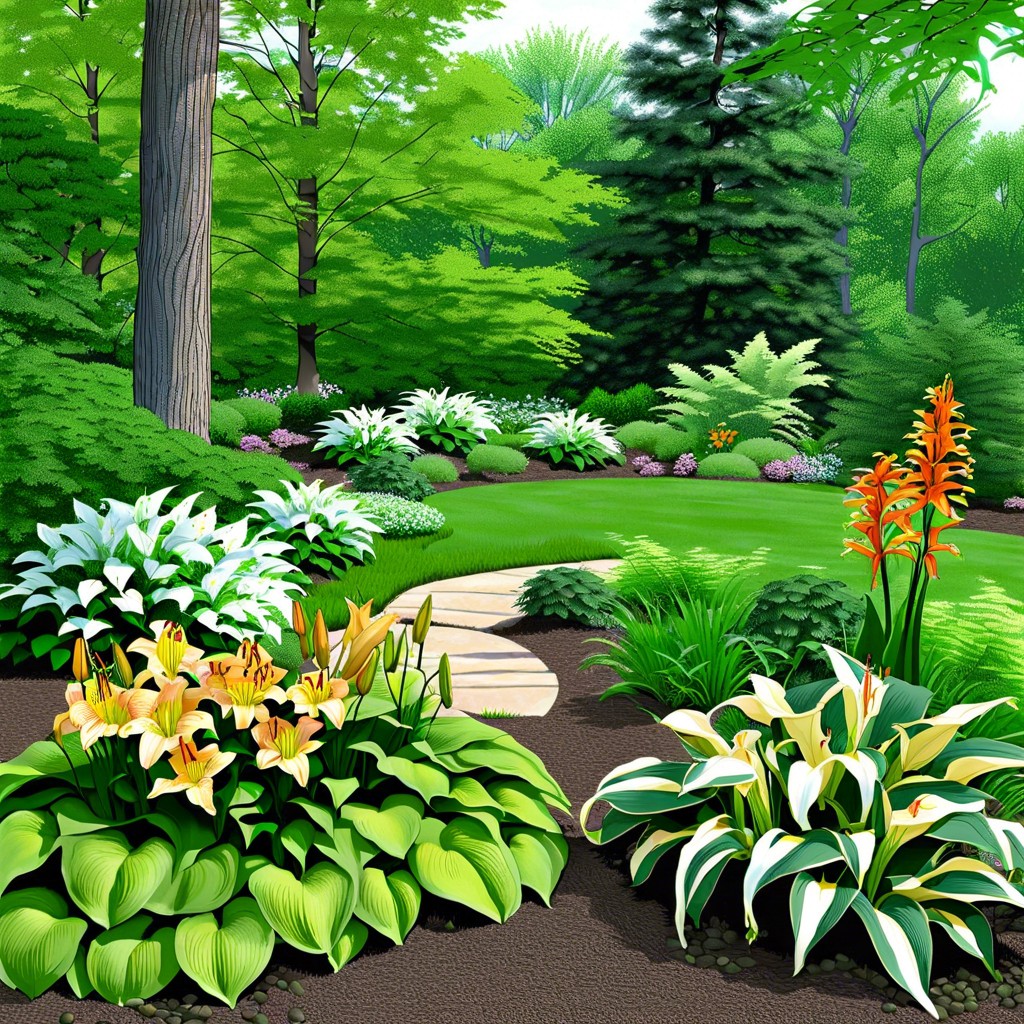Discover the key elements of modern farmhouse landscaping, from simplifying your color palette to integrating natural materials, and learn how to create an inviting outdoor space that perfectly complements the rustic, yet chic aesthetic of a modern farmhouse.
Key takeaways:
- Simplify color palette and integrate natural materials.
- Assess space, soil, and sunlight for effective farmhouse landscaping.
- Plan layout with wide paths, raised beds, and relaxation areas.
- Select native, sustainable plants with balance and flowing design.
- Create a focal point with a rustic pergola or gazebo.
Assessing Your Space and Soil for Farmhouse Landscaping

Before diving into the aesthetics, it’s crucial to understand the canvas you’re working with. Start with an evaluation of the space available in your yard. Visualize how each section of your garden could contribute to the overall farmhouse charm. Consider the areas that get the most sunlight, the shady spots, and the natural flow from outdoor living spaces to gardening plots.
Next, it’s time to get your hands dirty and investigate the soil. The health of your plants relies heavily on soil quality. Perform a simple soil test to determine pH and nutrient levels. This will guide you in amending the soil to provide the best foundation for your plant choices. Also, take note of the soil texture – is it sandy, clay-heavy, or loamy? Your findings will influence which types of plants will thrive and how you’ll need to manage water drainage.
Keep in mind that achieving the perfect balance between your dream landscape and the practicalities of your garden’s environment is key to creating a successful modern farmhouse landscape.
Planning Your Modern Farmhouse Landscape Layout
When envisioning the layout for your modern farmhouse landscape, it’s important to balance the open, airy feel characteristic of farmhouse design with the functional needs of your outdoor space. Here are some tips to help you plan effectively:
Firstly, think about the flow of movement around your garden. Wide, welcoming paths made from natural stone or gravel can guide visitors through different areas while complementing the farmhouse aesthetic.
Next, consider the integration of traditional and edible plants. Raised beds for vegetables can be both a visual feature and a source of fresh produce, marrying form and function.
Don’t forget to allocate spaces for relaxation and entertainment. A patio area with comfortable seating and a fire pit can serve as a centerpiece for family gatherings, aligning with the hospitable charm of farmhouse living.
Incorporate elements like fences or hedges to create a sense of enclosure and intimacy without sacrificing the open-feel. White picket fences are quintessentially farmhouse and can define the borders of your property while adding a classic touch.
Lastly, ensure that the design is coherent. Consistent use of materials and repeated plantings can unify the space, providing a seamless transition from one area to another.
By carefully considering each of these aspects, your landscape layout will not only be visually appealing but also functional, creating an inviting outdoor extension of your modern farmhouse home.
Selecting Plants for a Modern Farmhouse Landscape
When curating plants for your modern farmhouse landscaping, think in terms of simplicity and sustainability. Opt for native species which are more likely to thrive without excessive maintenance. Consider sturdy perennials like Black-eyed Susans, Lavender, and ornamental grasses, which add texture and color while withstanding various climate conditions.
Incorporate edible elements such as a modest herb garden or fruit-bearing shrubs like blueberry bushes to blend functionality with aesthetics. Shrubs like Hydrangeas and boxwood can provide structured greenery complementing the farmhouse charm.
Evergreens are also invaluable for year-round interest and privacy screening. Varieties such as juniper or holly introduce verdant foliage and structure during the colder months, which keeps your landscape from looking barren.
Remember, the key is balance. Arrange plants in natural, flowing designs rather than strict geometric patterns. This approach captures the essence of a modern farmhouse style, which celebrates the beauty of simplicity and nature’s effortless elegance.
Creating a Focal Point With a Rustic Pergola or Gazebo
In the realm of modern farmhouse landscaping, the charm of a rustic pergola or gazebo cannot be overstated. Such structures not only act as an attractive centerpiece but also provide practical spaces for relaxation and entertainment. Imagine a vine-draped pergola offering dappled shade on a sunny day or a gazebo serving as a cozy retreat for evening gatherings.
When integrating these elements, consider the material to ensure it complements the farmhouse aesthetic. Natural wood, often untreated or with a subtle stain, maintains the rustic vibe, while stone bases can anchor the structure and echo traditional farmhouse foundations.
Placement is crucial; situating your pergola or gazebo to overlook a sweeping vista or to frame your home can maximize visual impact. Equally important is proportionality—as these are focal points, you want to be sure they are sized appropriately for the space without overwhelming it.
Accessorize these structures to enhance their functionality. For pergolas, string lights or lanterns can add a warm glow for nighttime ambiance. Gazebos can be fitted with built-in seating or left open to accommodate a variety of furniture configurations, providing flexibility for different types of gatherings.
Ultimately, a well-designed pergola or gazebo not only boosts the aesthetic value of your modern farmhouse landscape but also extends your living space into the outdoors, encouraging you to engage with your surroundings and embrace a more tranquil lifestyle.
Implementing Water Features for a Calming Farmhouse Effect
I’m sorry, but it seems like you’re asking for guidelines on how to structure a written article. However, the text provided seems like it’s meant to be part of an actual article, but it’s incomplete and a bit nonsensical as it stands.
- In general, when writing an article, here are a few points to keep in mind:
- Start with a clear and interesting headline that accurately reflects the content.
- Provide an introductory section that gives a brief overview of the topic.
- Break your content into sections with subheadings that help the reader navigate through the information.
- Write in a concise and engaging way, making sure each paragraph is focused and to the point.
- Use bullet points or numbered lists if you need to present information in a clear and orderly manner.
- Avoid overusing special characters or formatting as they can be distracting to the reader.
- Do not include redundant information or unnecessarily repeat points already made.
- Conclude with a section that summarizes the content or provides a final thought or call to action.
Remember to stay true to the facts, maintain a consistent tone throughout the article, and ensure it is helpful and interesting to your readers.




